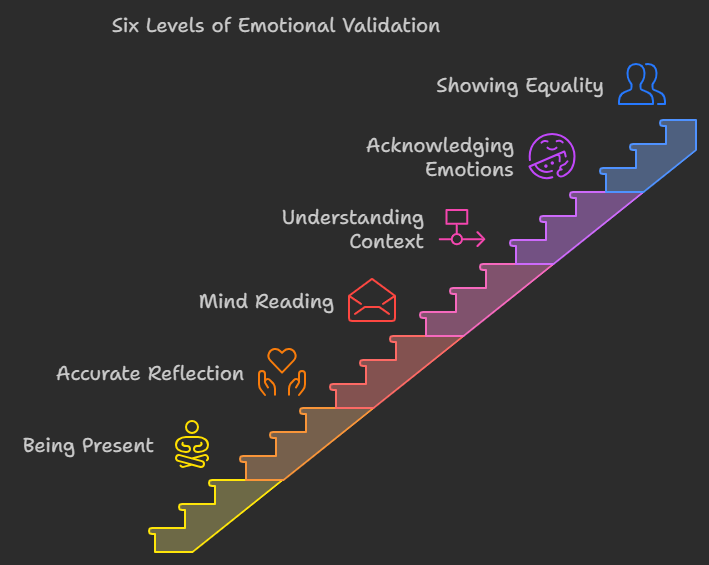Understanding the 6 Levels of Validation
Validation is important in human interaction. Did you know that there are six different levels of validation? Understanding these levels can improve communication and relationships. From basic recognition to empathetic understanding, each level is important in connecting with others.
In this article, we will break down each level of validation, providing a clear understanding of how they work and why they are important in our daily interactions. Whether at home, school, or work, knowing these levels can make a big difference in how we relate to others.
What is Validation, and Why is It Important?
The Basics of Validation
Validation is critical in relationships. It helps manage emotions and strengthen connections.
Being emotionally present and reflecting someone’s emotions accurately can help take the relationship to the next level. This involves understanding the person’s behavior in the context of their experiences and biology.
As individuals progress through the levels, they normalize emotional reactions and practice radical genuineness.
Common mistakes in validation include offering advice or judgment, dismissing emotions, and minimizing the other person’s experiences.
Instead, focus on acknowledging and understanding the other person’s feelings without trying to “fix” the situation.
Doing this can empower the other person and create healthier relationships.
Why Validation Matters in Relationships
Validation is important in relationships. It helps individuals feel heard, understood, and accepted by their partner, building trust, connection, and emotional intimacy. By acknowledging and validating each other’s emotions, thoughts, and experiences, couples create a supportive environment that fosters emotional well-being. Dialectical Behavior Therapy identifies six levels of validation, providing a framework for understanding and practicing validation in relationships.
The absence of validation can lead to feelings of rejection, loneliness, and emotional distress. It creates a sense of invalidation and misunderstanding, causing an emotional disconnect.
Breaking Down the Six Levels of Validation

Level One: Being Present
Being present in a relationship or interaction means being fully focused and engaged in the moment. This involves giving the other person your full attention, actively listening to what they are saying, and being aware of their emotional state.
By being present, individuals demonstrate empathy and understanding. This creates a sense of safety and connection for the other person. It also contributes to effective validation and understanding in relationships. It shows the other person that their feelings and experiences are important and valued. Overall, it allows for a deeper level of emotional connection and fosters trust.
Practical ways to enhance one’s ability to be present in communication and validation include practicing mindfulness techniques, such as deep breathing and actively grounding oneself in the present moment. Using nonverbal cues, such as maintaining eye contact and nodding, can demonstrate attentiveness and support. Additionally, setting aside distractions, such as phones and other electronic devices, helps one be fully present in interactions.
These strategies can all create a more validating and understanding environment in relationships.
Level Two: Accurate Reflection
Marsha Linehan identified six levels of validation. Each level requires a deeper understanding and empathy.
The first level is simply being present. Then comes accurate reflection, which involves understanding and mirroring the other person’s emotions and experiences.
As individuals progress through the levels, they learn to read a person’s behavior, understand it in the context of their history and biology, normalize their emotional reactions, and practice radical genuineness.
Progressing through these levels is important in relationships because it builds trust, understanding, and empathy.
By practicing accurate reflection and understanding, individuals can validate others by actively listening, empathizing with their emotions, and showing understanding of their experiences.
These practices strengthen relationships, help individuals manage emotions effectively, and make them feel empowered and supported in their interactions with others.
Level Three: Mind Reading
Mind reading helps people understand how others feel and think, even when they don’t say it outright. For example, if someone seems anxious but doesn’t admit it, a person skilled in mind reading can notice and provide support.
However, there’s a risk of misinterpreting someone’s feelings or thoughts. Assuming someone feels a certain way when they don’t can lead to misunderstandings.
To improve your mind-reading skills for validation, practice active listening and pay attention to body language, facial expressions, and tone of voice. This will help you understand others’ emotions and thoughts for more accurate validation.
Level Four: Understanding Behaviors in Context
Understanding behaviors in context is crucial for validation. It helps identify factors that shape emotions and reactions. Considering history, biology, and specific circumstances leads to a deeper understanding. This, in turn, allows for more accurate validation, creating stronger connections.
Understanding behaviors promotes empathy and compassion in relationships. Efforts to comprehend the reasons behind behaviors enhance the quality of validation. This fosters trust and understanding, creating a supportive environment.
To improve understanding for validation, individuals can actively listen, ask open-ended questions, and seek unique perspectives. Education about the impact of history and biology on behavior is also important. Reflecting on biases and assumptions is key. These efforts strengthen relationships and empower others.
Level Five: Acknowledging Emotional Responses
Acknowledging emotional responses is the fifth level of validation, as identified by Marsha Linehan in Dialectical Behavior Therapy (DBT). This level is important because it allows individuals to validate and accept the emotions of others, even when they do not make sense or seem unwarranted.
Acknowledging emotional responses can help individuals gain a deeper understanding of their own emotions and those of others, leading to more meaningful and fulfilling relationships. Progressing through the levels of validation, including acknowledging emotional responses, is important. It helps strengthen relationships, manage emotions, and empower individuals.
Some techniques for practicing and improving the skill of acknowledging emotional responses include:
- Active listening
- Asking open-ended questions
- Showing empathy
These techniques can allow individuals to show understanding and acceptance, even in the face of difficult emotions and situations.
Level Six: Showing Equality
There are 6 levels of validation in managing emotions:
- Being present
- Accurate reflection
- Reading a person’s behavior and guessing what they might be feeling or thinking
- Understanding a person’s behavior in terms of their history and biology
- Normalizing emotional reactions
- Radical genuineness
Each level deepens the connection and understanding between individuals. Progressing through the levels is important because it helps strengthen relationships, manage emotions, and empower individuals.
For example, when someone feels validated at the first level of being present, it encourages them to share more, which allows for a more accurate reflection of their emotions. Individuals feel more understood and supported as the levels progress, leading to increased trust and a stronger sense of emotional security. This can be particularly beneficial for emotionally sensitive individuals, helping them to feel more secure and confident in their emotions.
What are the 6 Levels of Validation?
How Each Level Builds Upon the Last
Each level of validation is important. It builds on the last and forms a strong foundation for the next level.
For example, being present is the first level. It’s essential for accurate reflection. You can’t reflect accurately without being fully present. Moving through the levels of validation helps relationships. It builds trust and understanding. Validating each other’s emotions at deeper levels leads to a more empathetic and supportive relationship. Understanding and practicing the 6 levels of validation in relationships is important. It helps manage emotions and empowers individuals. Normalizing emotional reactions and being genuinely honest creates a safe space for communication. This strengthens relationships. This understanding and practice also contribute to overall emotional regulation and well-being.
The Importance of Progressing Through the Levels
Progressing through the levels of validation in relationships is important. It helps strengthen the bond between individuals and aids in managing emotions effectively. Each level of validation builds upon the last, deepening the understanding and connection between individuals.
For example, accurately reflecting a person’s feelings can lead to a greater sense of being understood. This, in turn, contributes to the normalization of emotional reactions. Not progressing through the levels of validation in relationships can lead to a lack of understanding, miscommunication, and emotional turmoil.
If a person’s feelings are not accurately reflected or understood in terms of their history and biology, it can result in feelings of invalidation and frustration. Therefore, progressing through the levels of validation is crucial in developing healthy, supportive relationships and empowering individuals to manage their emotions effectively.
How to Practice Understanding and Validation
Active Listening

Marsha Linehan identified six levels of validation. They build upon each other, creating a comprehensive approach to understanding and supporting individuals’ emotions. The first level involves simply being present, followed by accurate reflection. The next step is reading a person’s behavior and guessing what they might be feeling or thinking.
Understanding a person’s behavior in terms of their history and biology comes next, followed by normalizing emotional reactions and radical genuineness.
Progressing through these levels is essential. It helps the individual feel heard, understood, and validated, strengthening relationships and empowering them to manage their emotions effectively. Common mistakes to avoid in validation include overlooking nonverbal cues, such as body language and tone of voice, and minimizing the intensity of feelings. By recognizing and addressing these mistakes, individuals can improve their validation skills and better support those around them.
Expressing Empathy

To express empathy effectively, you can progress through the six levels of validation.
This involves being present, accurately reflecting the other person’s emotions, and understanding their behavior in the context of their history and biology.
Individuals can demonstrate genuine care and concern by avoiding common mistakes such as dismissing, minimizing, or invalidating the other person’s feelings.
Progressing through the six levels of validation is vital for supporting others in their emotional experiences. It helps strengthen relationships, manage emotions, and empower individuals.
For example, by normalizing emotional reactions and showing radical genuineness, individuals can create a safe and supportive environment where people feel understood and validated.
This fosters trust and open communication in relationships, leading to better emotional well-being for all involved.
Asking Questions

Validation is understanding, acknowledging, and accepting someone else’s experience and emotions. It’s important in relationships because it helps to build trust and connection, which are crucial for healthy relationships.
Each level of validation builds on the last by deepening the understanding and empathy expressed. Progressing through the levels is crucial because it allows for a more complete understanding of the other person’s experience, which strengthens the relationship and helps the individual feel seen and understood.
Active listening, showing empathy, asking questions, and validating one’s own feelings can all help with understanding and validation. By doing these things, individuals can show they are open to understanding the other person’s experience, leading to deeper connections and more meaningful relationships. Also, validating one’s own feelings can help individuals understand and accept their own experiences, which is important for emotional well-being.
Validating Your Own Feelings
Validating your own feelings is important for emotional well-being and healthy relationships. There are six levels of validation identified by Marsha Linehan that play a role in this process:
- Being present.
- Accurately reflecting.
- Reading a person’s behavior.
- Understanding their history and biology.
- Normalizing emotional reactions.
- Embracing radical genuineness
By doing these, individuals can effectively validate their own feelings, leading to improved emotional well-being, stronger relationships, and better emotional management.
For instance, when someone feels sad, and their partner shows understanding and empathy, it can lead to a more supportive relationship. Also, accepting their own emotions without judgment can lead to greater self-compassion. Understanding and practicing these levels of validation can have a positive impact on emotional health and relationships.
Helping Partners with Their Pain

Recognizing Partner Pain
Recognizing when your partner is in pain can be tough, but it’s really important for a healthy relationship. Some signs to look out for are changes in behavior, like being more irritable or withdrawing, and physical symptoms, such as trouble sleeping.
It’s important to notice and validate your partner’s pain because it can bring you closer and build trust. Understanding your partner’s feelings can help you manage emotions, strengthen your bond, and support each other.
In Dialectical Behavior Therapy, there are six levels of validation, like being present and sincerely acknowledging your partner’s feelings, which can help you respond supportively when your partner is in pain.
Easing Suffering through Validation
Each of the six levels of validation can be used in daily interactions to improve emotional well-being. Being present involves giving full attention to the person speaking and acknowledging their emotions. Accurate reflection means summarizing and reflecting on the person’s feelings to show understanding.
Reading a person’s behavior and guessing what they might be feeling, or thinking requires empathy and the ability to put oneself in the other person’s shoes. Understanding a person’s behavior in terms of their history and biology involves considering their past experiences and biological factors that may influence their emotions.
Normalizing emotional reactions involves reassuring the person that their feelings are valid and understandable, even in challenging situations. Radical genuineness encourages open and authentic communication, allowing individuals to express themselves without fear of judgment.
These levels of validation can be practiced in everyday conversations, helping to create supportive and validating relationships.
When to Seek Help
If you’re having trouble understanding your partner’s feelings, getting help is important. A relationship might need professional help with validation if there are many misunderstandings, recurring emotional conflicts, or if partners feel disconnected. Sometimes, you might notice that your efforts to validate your partner aren’t working. In these cases, it’s a good idea to seek help from a therapist or counselor skilled in validation techniques.
This can improve communication and emotional connection in the relationship.
Common Mistakes in Validation
Overlooking Nonverbal Cues
Nonverbal cues, like body language, facial expressions, and tone of voice, are crucial for communication validation. Missing these cues can cause misunderstandings and lead to dismissing or minimizing someone’s experience.
Crossed arms, lack of eye contact, or fidgeting are common cues indicating discomfort or defensiveness. Recognizing these cues is important because they give insights into a person’s emotional state and help avoid invalidating their feelings.
Responding to nonverbal cues can build trust, empathy, and understanding in relationships. Mirroring someone’s body language or acknowledging their emotions based on nonverbal cues can help them feel heard and understood. This fosters a supportive environment where emotions are acknowledged and validated.
Ignoring Context
Ignoring context is a common mistake when it comes to validation. People often fail to consider an individual’s specific circumstances and history when trying to validate their emotions.
For example, if someone feels anxious, it’s important to understand that their past experiences, biology, and other factors may contribute to their current emotional state. Ignoring this context may make the validation offered superficial and ineffective.
Practicing validation helps individuals understand and apply the six levels of validation more effectively.
For instance, when someone can recognize and reflect a person’s emotions accurately, it shows that they have considered the context in which those emotions occur. This leads to a more meaningful and genuine validation, strengthening the emotional connection between individuals and promoting a deeper understanding of their emotions.
By acknowledging and validating the context in which emotions arise, individuals can better navigate the six levels of validation and foster healthier emotional development.
Minimizing Feelings
The six levels of validation can help minimize feelings in a validating way.
- Be present.
- Accurately reflect a person’s emotions.
- Read their behavior and guess their feelings.
- Understand their behavior in the context of their history and biology.
- Normalize emotional reactions.
- Practice radical genuineness.
One common mistake is dismissing or downplaying emotions, which can lead to further distress.
Acknowledging and validating feelings is important.
It helps build trust, strengthen relationships, and empower individuals to manage their emotions effectively.
Feeling heard and understood can improve emotional well-being.
What are the 6 Levels of Validation?
Practice Makes Perfect
The six levels of validation in Dialectical Behavior Therapy build upon each other. They start with basic presence and accurate reflection. Then, they progress to understanding a person’s behavior in the context of their history and biology. Finally, they land on radical genuineness. Each level serves as a foundation for the next, culminating in the ultimate goal of validating someone’s emotions and experiences.
Individuals can practice understanding and validation in relationships by actively listening, reflecting, and empathizing with the other person’s emotions. It involves acknowledging and accepting the other person’s feelings without judgment, even if they do not align with one’s own experiences or beliefs.
Common mistakes to avoid when practicing validation include:
- Minimizing the other person’s emotions.
- Trying to offer quick solutions or advice.
- Dismissing or invalidating their feelings.
Instead, individuals should focus on acknowledging and empathizing with the other person’s emotions without trying to fix their problems or change their feelings. This creates a safe and validating environment for open communication and emotional support.

Vizologi is a revolutionary AI-generated business strategy tool that offers its users access to advanced features to create and refine start-up ideas quickly.
It generates limitless business ideas, gains insights on markets and competitors, and automates business plan creation.


